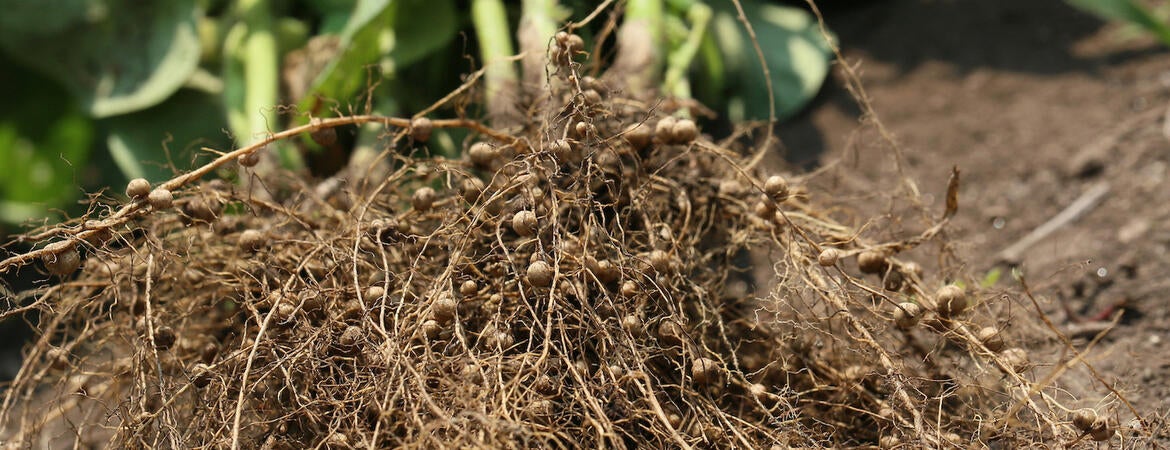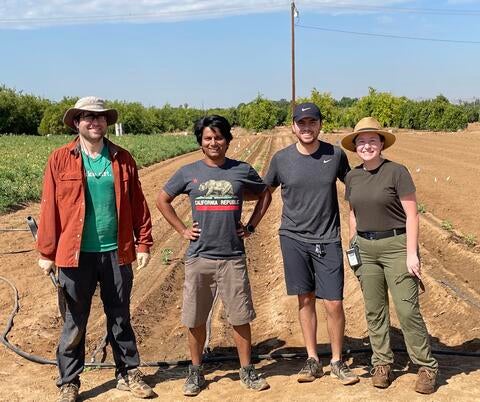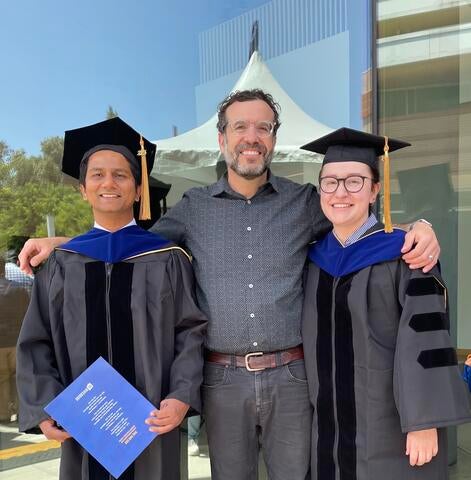
Plants form alliances with microbes in the soil in which they grow. Legumes, for example, benefit from a symbiotic relationship with microbes that inhabit nodules in their roots and “fix” nitrogen in the atmosphere to make it available to promote the legumes’ growth. But are microbes always beneficial to plants? Or does competition between strains for plant access degrade the service the bacteria ultimately provide?
A team led by scientists at the University of California, Riverside, set up experiments to answer these questions and better understand the competition process. The researchers used a native California plant with nodules, Acmispon strigosus, and a set of eight compatible nitrogen-fixing bacterial strains. They infected some plants with each of the eight strains to directly measure their ability to infect the plants and provide benefits. They then infected other plants with pairs of bacterial strains to assess the competitive ability of each strain and the effect on plant performance.
The researchers found that competition between strains of beneficial bacteria in the soil degrades the service that the bacteria provide to their hosts.
“More specifically, we found interstrain competition that occurs in the soil before the bacteria infect the plant causes fewer of the bacteria to colonize the plant, resulting in the plant gaining smaller benefits in the end,” said Joel Sachs, a professor of evolution, ecology, and organismal biology, who led the research team. “To understand symbiosis, we often use sterile conditions where one strain of bacteria is ‘inoculated’ or introduced into an otherwise sterile host. Our experiments show that making that system slightly more complex — simply by using two bacterial strains at a time — fundamentally shifts the balance of benefits that the hosts receive, reshaping our understanding of how symbiosis works.”
Study results appear in the journal Current Biology.
Sachs explained that a core challenge in agriculture is leveraging the services that microbes can provide to crops by promoting growth in a sustainable way, without the environmental costs of chemical fertilizers. His lab studies rhizobia — bacteria that promote plant growth. Rhizobial competition is a longstanding problem for sustainable agriculture. Rhizobia form root nodules on legumes, within which the bacteria fix nitrogen for the plant in exchange for carbon from photosynthesis. Growers have long sought to leverage rhizobia to sustainably fertilize staple legume crops such as soybean, peanuts, peas, and green beans.
“One might think using rhizobia as inoculants should allow growers to minimize the use of chemical nitrogen, which is environmentally damaging,” said Sachs, who chairs the Department of Evolution, Ecology, and Organismal Biology. “But such rhizobial inoculation is rarely successful. When growers inoculate their crops with high-quality rhizobia — strains that fix a lot of nitrogen — these ‘elite’ strains get outcompeted by indigenous rhizobia that are already in the soil and provide little or no benefit to hosts.”
In their experiments, Sachs and his colleagues used bacterial strains whose genomes they had already sequenced. They also characterized the strains, which ranged from highly beneficial to ineffective at nitrogen fixation, to know exactly how beneficial they were to the target plant species. The researchers sequenced the contents of more than 1,100 nodules, each of which was from a plant that was inoculated with one of 28 different strain combinations.
Next, the researchers developed mathematical models to predict how much benefit co-inoculated plants would gain based on expectations from plants that were “clonally infected” (infected with one strain). This allowed the researchers to calculate the growth deficit that was specifically caused by interstrain competition.
“Our models showed that co-inoculated plants got much lower benefits from symbiosis than what could be expected from the clonal infections,” said Arafat Rahman, a former graduate student in Sachs’ lab and the first author of the research paper. “While beneficial bacteria work well in the lab, they get out-competed in the natural environment. Ultimately, we want to find a strain of bacteria — or a set of them — that gives maximum benefit to the host plant and is competitive against bacterial strains that are already in the soil.”
Sachs explained that to discover and develop a bacterial strain that is highly beneficial to plants, scientists need to conduct experiments under very clean conditions.
“Ultimately, we want to use beneficial bacteria in agriculture,” he said. “To identify these bacteria, we would, typically, add one bacterial strain to a plant in the lab and show that the plant grows much better with the strain than without. In the field, however, that plant is covered in microbes, complicating the story. In our experiments, we advanced from using one strain to a pair of strains to see what impact that has on plant growth. Interestingly, with just two strains, many of our predictions fell apart.”
Rahman stressed that while experiments are needed to ascertain how beneficial a bacterial strain is, experiments that test how competitive the strain is against a panel of other bacterial strains are also needed.
“Both steps are crucial,” he said. “Our work found some of the best strains can be highly beneficial to plant growth but as soon as you pair them with any other strain, that benefit is greatly reduced. Further, it is important to know at which stage the interstrain competition takes place: before the bacteria interact with the plant or after? Our work suggests it’s the former and provides a useful guide to designing future experiments aimed at discovering strains that are better for delivery in crops.”
Sachs said that in a lot of current experimental designs the focus is on the benefit to plants.
“It’s important, however, to keep in mind that bacteria are shaped by natural selection,” he said. “Some of them may be highly competitive in entering the nodule to infect the plant but not be very beneficial to the plant and that could be a trait that wins out in nature. If we are to leverage microbial communities for the services they can provide to plants and animals, we need to understand interstrain dynamics in these communities.”
According to Sachs and Rahman, sustainable growth practices need to be a critical aspect of new agriculture to feed a growing population on a limited resource base.
“This will require moving past polluting methods such as adding huge amounts of chemical nitrogen to soil,” Sachs said. “Understanding how to efficiently deliver beneficial microbes to a target host is a central challenge in medicine, agriculture, and livestock science. By revealing that interstrain dynamics can reduce the benefits of symbiosis, our work has opened new avenues of research to improve sustainable agricultural practices.”
Sachs and Rahman were joined in the study by Max Manci, Cassandra Nadon, Ivan A. Perez, Warisha F. Farsamin, Matthew T. Lampe, Tram H. Le, and Lorena Torres Martínez of UCR, and Alexandra J. Weisberg and Jeff H. Chang of Oregon State University. Rahman plans to join Oregon State University as a postdoctoral researcher.
The research was supported by grants from the National Science Foundation and the U.S. Department of Agriculture.
The title of the research paper is “Competitive interference among rhizobia reduces benefits to hosts.”
Header image credit: kellymarken/iStock/Getty Images Plus






